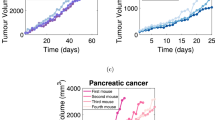Abstract
Data-driven model validation across dimensions in mathematical and computational biology assumptions are often made (e.g., symmetry) to reduce the problem from three spatial dimensions (3D) to two (2D). However, some experimental datasets, such as cell counts obtained via flow cytometry, represent the entire 3D biological object. For purpose of model calibration and validation, it is sometimes necessary to compare these biological datasets with model outputs. We propose a methodology for scaling 2D model outputs to compare with 3D experimental datasets, and we discuss the application of this methodology to two examples: agent-based models of granuloma formation and skeletal muscle tissue. The accuracy of the method is evaluated in artificially generated scenarios.






Similar content being viewed by others
Notes
For details on how bacterial counts are obtained, please see the Methods section of Mattila et al. (2013)
References
Cilfone N, Kirschner D, Linderman J (2015) Strategies for efficient numerical implementation of hybrid multi-scale agent-based models to describe biological systems. Cell Mol Bioeng 8(1):119–136
Cilfone NA, Ford CB, Marino S, Mattila JT, Gideon HP, Flynn JL, Kirschner DE, Linderman JJ (2015) Computational modeling predicts IL-10 control of lesion sterilization by balancing early host immunity-mediated antimicrobial responses with caseation during Mycobacterium tuberculosis infection. J Immunol 194(2):664–677
Fallahi-Sichani M, El-Kebir M, Marino SKD, Linderman J (2011) Multi-scale computational modeling reveals a critical role for TNF-\(\alpha \) receptor 1 dynamics in tuberculosis granuloma formation. J Immunol 186(6):3472–83
Gong C, Mattila J, Miller M, Flynn J, Linderman J, Kirschner D (2013) Predicting lymph node output efficiency using systems biology. J Theor Biol 335:169–184
Kirschner D, Hunt A, Marino S, Fallahi-Sichani M, Linderman J (2014) Tuneable resolution as a approach to study multi-scale, multi-organ models in systems biology. Wiley Interdiscip Rev Syst Biol Med 6(4):289–309
Marino S, Hult C, Wolberg P, Linderman JJ, Kirschner D (2018) The role of dimensionality in understanding granuloma formation. Computation 6(4):58
Martin K, Blemker S (2015) Peirce S agent-based computational model investigates muscle-specific responses to disuse-induced atrophy. J Appl Physiol (1985) 118(10):1299–309
Martin K, Kegelman C, Virgilio K, Passipieri J, Christ G, Blemker S, Peirce S (2017) In silico and in vivo experiments reveal M-CSF injections accelerate regeneration following muscle laceration. Ann Biomed Eng 45(3):747–760
Mattila J, Ojo O, Kepka-Lenhart D, Marino S, Kim J, Eum S, Via L, Barry C, Klein E, Kirschner D, Morris SM, Lin PL, Flynn J (2013) Microenvironments in tuberculous granulomas are delineated by distinct populations of macrophage subsets and expression of nitric oxide synthase and arginase isoforms. J Immunol 191(2):773–784
Segovia-Juarez J, Ganguli S, Kirschner D (2004) Identifying control mechanisms of granuloma formation during M. tuberculosis infection using and agent based model. J Theor Biol 231(3):357–376
Virgilio K, Martin K, Peirce S, Blemker S (2018) Agent-based model illustrates the role of the microenvironment in regeneration in healthy and mdx skeletal muscle. J Appl Physiol (1985) 125(5):1424–1439
Acknowledgements
We thank Josh Mattila for the stained granuloma image, Joanne Flynn for the monkey lung image, and Caitlin Hult for generating the 3D GranSim image (all shown in Fig. 1). This research was supported by the following NIH Grants awarded to JL and DK: R01 AI123093 and U01HL131072. SB and SP are supported by NIH Grant U01AR069393. This research also used resources of the National Energy Research Scientific Computing Center, which is supported by the Office of Science of the U.S. Department of Energy under Contract No. DE-AC02-05CH11231 and the Extreme Science and Engineering Discovery Environment (XSEDE), which is supported by National Science Foundation Grant Number MCB140228.
Author information
Authors and Affiliations
Corresponding author
Additional information
Publisher's Note
Springer Nature remains neutral with regard to jurisdictional claims in published maps and institutional affiliations.
Electronic supplementary material
Below is the link to the electronic supplementary material.
Rights and permissions
About this article
Cite this article
Renardy, M., Wessler, T., Blemker, S. et al. Data-Driven Model Validation Across Dimensions. Bull Math Biol 81, 1853–1866 (2019). https://doi.org/10.1007/s11538-019-00590-4
Received:
Accepted:
Published:
Issue Date:
DOI: https://doi.org/10.1007/s11538-019-00590-4




